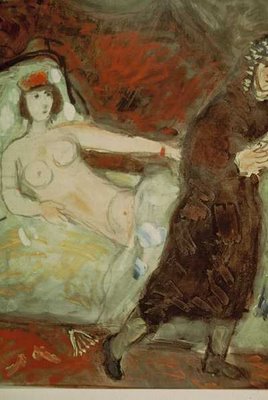Paul Grant (Follower of Basho)
Left, Simon C. Dickinson, London; right, Wildenstein & Company
(If you have others we should look at please let us know. This shows a pretty wide varriety of interpetations of the theam.)

Solimena's "Joseph and Potiphar's Wife" (1689-90), left, is being offered for $2 million at the European Fine Art Fair in the Netherlands, while a version of that theme by Gauguin from 1896 is going for $25 million.
I found this interesting comparison of the two pictures on the same theme in an artical in The New York Times entitled : Modern Art Steps Up at Fair of Old Masters.
The artical was about an Old Masters Fair celebrating it's 27th anniversary, suddennly shpwong more modern works including prime examples of works by Picasso, Magritte, Mondrian, Jasper Johns, Robert Rauschenberg and Claes Oldenburg, and these modern masters selling well.
Modern is a clumbsy word to choose for a period, since it indicates a continuation of contemporay that actually does not exist. Choosing a better word for this time period will make for easier comprehension by students of art history in the future.
I will put a link for the New York Times artical at the bottom.
I wanted to add a little more information for our comparison of the two pictures.
First what is the scene being depicted by Joseph and Potiphar's Wife?
(see Genesis 39:1).
Joseph was a righteous young man who had been sold into Egypt. He served Potiphar, captain of Pharaoh's guard. Potiphar trusted Joseph and gave him an important position in his house. Potiphar's wife liked Joseph and kept trying to get Joseph to do wrong. Joseph refused to give in to her. Then one day Potiphar's wife caught hold of Joseph's cloak and tried to tempt him to sin. Again he refused, and he ran from the room, leaving his cloak in her hand. Potiphar's wife called to the men of the house and claimed that Joseph had come to try to do wrong with her. She told the same untrue story to Potiphar, who had Joseph put into prison. But the Lord was with Joseph and blessed him.:
"But the Lord was with Joseph" (Genesis 39:21). He loved Joseph and helped the keeper of the prison to think well of him. Soon the keeper of the prison put Joseph in charge of the other prisoners and all that went on in the prison. Joseph was successful, even in prison, because he was obedient and the Lord was with him. (See Genesis 39:2123.)
What other examples do we have of work on this theam?
I found this interesting comparison of the two pictures on the same theme in an artical in The New York Times entitled : Modern Art Steps Up at Fair of Old Masters.
The artical was about an Old Masters Fair celebrating it's 27th anniversary, suddennly shpwong more modern works including prime examples of works by Picasso, Magritte, Mondrian, Jasper Johns, Robert Rauschenberg and Claes Oldenburg, and these modern masters selling well.
Modern is a clumbsy word to choose for a period, since it indicates a continuation of contemporay that actually does not exist. Choosing a better word for this time period will make for easier comprehension by students of art history in the future.
I will put a link for the New York Times artical at the bottom.
I wanted to add a little more information for our comparison of the two pictures.
First what is the scene being depicted by Joseph and Potiphar's Wife?
(see Genesis 39:1).
Joseph was a righteous young man who had been sold into Egypt. He served Potiphar, captain of Pharaoh's guard. Potiphar trusted Joseph and gave him an important position in his house. Potiphar's wife liked Joseph and kept trying to get Joseph to do wrong. Joseph refused to give in to her. Then one day Potiphar's wife caught hold of Joseph's cloak and tried to tempt him to sin. Again he refused, and he ran from the room, leaving his cloak in her hand. Potiphar's wife called to the men of the house and claimed that Joseph had come to try to do wrong with her. She told the same untrue story to Potiphar, who had Joseph put into prison. But the Lord was with Joseph and blessed him.:
"But the Lord was with Joseph" (Genesis 39:21). He loved Joseph and helped the keeper of the prison to think well of him. Soon the keeper of the prison put Joseph in charge of the other prisoners and all that went on in the prison. Joseph was successful, even in prison, because he was obedient and the Lord was with him. (See Genesis 39:2123.)
What other examples do we have of work on this theam?
(If you have others we should look at please let us know. This shows a pretty wide varriety of interpetations of the theam.)

CIGNANI, Carlo
Italian painter, Bolognese school (b. 1628, Bologna, d. 1719, Forli)
Joseph and Potiphar's Wife
1678-80
Oil on canvas, 99 x 99 cm
Gemäldegalerie, Dresden
1678-80
Oil on canvas, 99 x 99 cm
Gemäldegalerie, Dresden




No comments:
Post a Comment